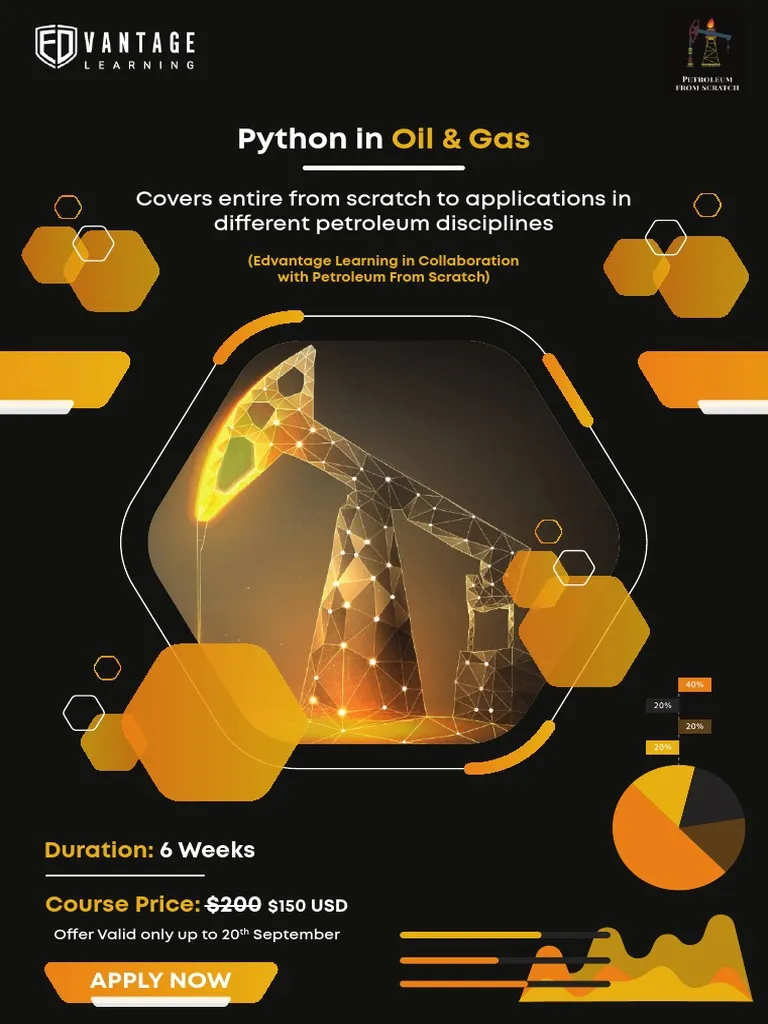Course Objective: Python is a computer programming language often used to build websites and software, automate tasks, and conduct data analysis. Python is a general-purpose language, meaning it can be used to create a variety of different programs and isn't specialized for any specific problems.
Combining petroleum engineering domain expertise with computer programming using "Python" as the most popular coding language for data science, artificial intelligence and machine learning, this course enables petroleum engineering professionals to build predictive models to solve the most common petroleum engineering
Learning Objective: The ability to understand your data and extract value from it is a key metric in the oil and gas industry today.
Prerequisites: specifically designed for engineers, scientists, data technicians and related practitioners in the oil & gas subsurface sector who are interested to learn python programming for the purpose of data extraction, analysis and manipulation
Duration: 20+ Hours
Topics to Be Covered:
A. Python Fundamentals:
Module 1: Introduction to Python and Computer Programming Python
- Python a tool, not a reptile
- There is more than one Python
- Let's start our Python adventure
Module 2 - Data Types, Variables, Basic Input-Output Operations, Basic Operators
- Your first program
- Python literals Operators
- data manipulation tools Variables
- data-shaped boxes
- How to talk to computer
Module 3 - Boolean Values, Conditional Execution, Loops, Lists and List Processing, Logical and Bitwise Operations
- Making decisions in Python
- Python's loops
- Logic and bit operations in Python
- Lists - collections of data
- Sorting simple lists - the bubble sort algorithm
- Lists - some more details
- Lists in advanced applications
Module 4 - Functions, Tuples, Dictionaries, and Data Processing
- Writing functions in Python
- How functions communicate with their environment?
- Returning a result from a function Scopes in Python
- Let's make some fun... sorry, functions
- Tuples and dictionaries
Module 5 - Modules, Packages, String and List Methods, and Exceptions
- Using modules
- Some useful modules
- What is package?
- Errors - the programmer's daily bread
- The anatomy of exception
- Four simple programs
B. Data Analytics for Oil & Gas
1. Effective Computations with NumPy:
- NumPy Introduction
- NumPy Arrays
- Arrays Dimension and Shape
- Arrange and Lin-space
- Zeroes, Ones, and Identity
- Array Indexing
- Array Slicing
- Arrays Indexing Higher Dimensional Arrays
- NumPy Functions
- Application of array slicing in Machine Learning
- Array Reshape
- Data Distributions
- Random Number Generation
2. Data Manipulation with Pandas: Data frame, csv, excel etc.
3. Oil and Gas Projects
4. Confidently use Python to solve different Reservoir parameters such as, porosity, water saturation evaluation in sandstone and carbonate reservoirs, different approach in shale evaluation, logs relationship, and representing various cross plot such as Pickett plot.
5. Plotting and Visualization with matplotlib
6. Brief introduction of Jupiter Notebook and python programming
7. Introduction of data analytics application in upstream
8. Easily create high-quality visualization of petroleum problems
C. Python in Oil & Gas Projects
The fundamental aim is to teach participants about exploratory data analysis, machine learning workflows, and, most significantly, data analytics and machine learning use cases in Oil & Gas applications. A number of case studies will be addressed to provide participants a better understanding of the applicability.
D. Data Analytics Research Projects
- Comparison between Vogel's and Fetkovich's Model for IPR
- Effect of Skin on Bottom Hole Pressure
- Future IPR
- Gas Material Balance
- MBAL Oil
- Spinner Log Analysis
- The Klingenberg Effect
- Vogel's IPR
- Well Test
- 1D Pressure Diffusion Numerical
Solution
E. Trainee Custom Projects : Admin Testing


